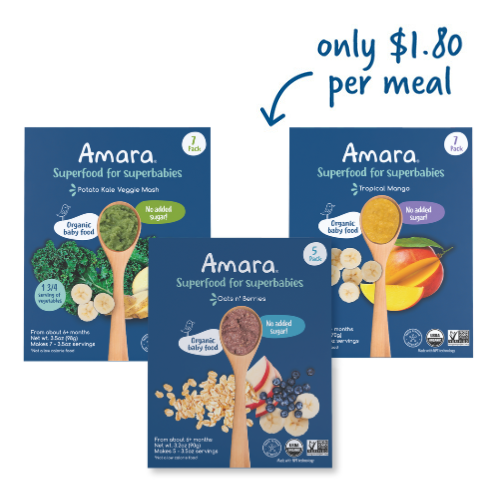
Complementary Feeding: Introducing Meat, Fat, Spices, Salt & Sugar
We get a lot of questions from parents who are knee-deep in starting solids about when and how to introduce certain foods or additives to their babies. (If you’re gearing up for this stage, check out our comprehensive guide to starting to solids for some background on diving in, including timing, readiness signs, first foods, feeding tips, schedules and more.)
In specific, parents recently have been inquiring about whether, when and how to incorporate meat (& fish), fat, spices, and sugar into their babies’ diets.
Here’s the rundown:
Contrary to what you may think, meat and fish can be introduced to babies as early as 6 months -- they offer numerous micronutrients, including iron and zinc, and also contain arachidonic acid, which is critical for brain development (it’s a kind of polyunsaturated fatty acid, and yes, it sounds like it came straight out ofHarry Potter). Of course, fatty fish (e.g. salmon) are also rich in omega 3, and meat and fish are generally protein dense.
The iron content in meat/fish is worth dwelling on briefly, because the kind of iron found in these animal foods -- heme iron -- is more bioavailable than the non-heme iron found in plant foods (meaning, it’s easier for the body to access). Why is this important? Iron concentrations in breast milk decrease with the duration of lactation (regardless of maternal diet and iron status), and typically begin to fall off at about 6 months. Globally, iron deficiency (which incidentally often coincides with zinc deficiency) is one of the most common micronutrient deficiencies among infants and young children. And though there are many complementary foods that offer iron, in the US, meat and iron-fortified cereals tend to be the two most widespread options. (Tip: serving vitamin C in tandem with non-heme iron-rich foods boosts iron bioavailability.)
Verdict: Pureed meats and fish can be introduced as first complementary foods and offer both iron and zinc, among other nutritional benefits.
How-to: Experts recommend boiling, pureeing, and serving “plain” 1 oz. servings (no salt, sweeteners, flavors, preservatives) to start off, in combination with a grain or veggie -- it pairs well with a vegetable- or potato-based dish from Amara! You can read more about feeding meat to your baby here. (Tip: use ice cube trays to freeze leftover puree -- simply defrost a cube for an easy portion.)
BTW -- if you are vegetarian/vegan or for whatever reason don’t want to feed your baby meat, Amara’s plant-based protein flavors were specifically developed to offer complementary amino acids which, in tandem, mirror more absorbable animal proteins.
Fat
Fat has a bad rap -- but this is changing! We all need fat in our diets, and for children especially, dietary fat iscrucial. It’s energy dense, contains essential fatty acids, both supplies and helps with vitamin absorption (like A, D, E, and K), and is foundational for the production of hormones. Not to mention, fat is SO important for early brain development and functioning: lipids (fatty acids) help make up the central nervous system structure itself and also play a major functional role in stimulating neurological development and growth.
To give you a sense of things, babies derive roughly 40-50% of their energy fromfat in breast milk or formula.So, yeah.
The concern with introducing babies to a diet of low-fat complementary foods is that such foods deprive them of the energy intake their growing bodies and brains need -- because babies can’t eat enough low-fat foods (in terms of quantity) to make up the difference. In the worst-case scenario, over time this could lead to limited growth. Furthermore, since taste preferences are forming during infancy and early childhood, avoiding fatty complementary foods may steer children off-track from healthy habits, and in case you haven’t read the news in the last decade, the entire low-fat worldview waswrong. (That’s another story for another day…)
Verdict: Fat is an important component of the diet in the first few years of life and shouldn´t be restricted.
How-to: Simply adding 1-2 teaspoons of oil (organic, cold-pressed) to the main meal of the day can take its energy-from-fat up by 10%. Aim for organic, cold-pressed oils rich in mono- or polyunsaturated fatty acids (aka essential fatty acids) like rapeseed, flaxseed, olive, or avocado. A sliver of butter can work in a pinch, too.
Spices
You may think that adding spices to complementary foods for your baby sounds unusual, but it’s not around the world. That said, the ideal approach to infant feeding in the first year is about building layers. A foundation, if you will.
Babies have very sensitive tastes, especially early on, and don’t need highly advanced or developed recipes (seriously, they don’t). A sensible approach is to introduce a baby first to a “plain” food, and allow her time to become familiar with the food, before adding *small amounts of spices to it. Please note: you don’thave to add spices to complementary foods; spices don’t necessarily contribute any nutrients or calories to a dish, so using them is more about exposing babies to a greater variety of nuanced flavors than anything else.
Verdict: There’s no need to incorporate spices into complementary foods from a nutritional perspective, but doing so gradually and in small doses can help expand a baby's palate early on 😉.
How-to: Once your baby is accustomed to a food, you may opt to add in tiny amounts of aromatic spices or mild herbs to mix things up. Use sparingly and periodically (not daily); *and avoid hot spices! You can read more about starter spices for complementary foods here.
Salt
Based on what we know about breast milk composition and infant nutritional demands, babies need almost no salt -- their average salt intake is less than 1g/daily (in case you didn’t know 🙋🏻♀️-- this is only 0.176 teaspoons), which they easily achieve via breast milk, formula, and/or other solid dishes (that don’t include added salt). In fact, an infant’s kidneys aren’t designed to cope with much more than this paltry amount. Thus, there is no reason to add salt to a baby’s food.
Furthermore, salt-taste sensitivities and preferences start to develop as early as 3-4 months of age --wow -- and adding salt to complementary foods only stands to increase a baby’s taste preferences for salty foods… which isn’t necessarily a good thing.
Verdict: Added salt is unnecessary in a baby’s diet, and too much of it can be deleterious. Best to leave it out.
How-to:Pass on the shaker. LOL.
Sugar
You probably already know that humans have an innate preference for sweet flavors -- scientists can see it in action even among 6-month-olds, who already prefer sweeter drinks.
But -- you probably also already know that Too Much Sugar contributes to myriad health problems spanning from early childhood well through adulthood. So perhaps it’s no surprise: there isn’t any need to add sugar to complementary foods for babies (or to foods for anybody of any age, for that matter).
Yes, our bodies need glucose to function properly, but we can get plenty of glucose from natural sources (such as whole grain cereals, legumes, fruits, vegetables, and breast milk/formula for babies). Additional sucrose (table sugar) not only constitutes empty calories but also contributes to an addictive process whereby sweet flavors trigger the release of dopamine, and we then go on to seek them out. It’s not a good cycle -- and adding sugar to babies’ foods risks setting them up for this exact situation come childhood, plus establishing unhealthy eating and feeding habits that are hard to kick. (You can learn more about the harmful effects of added sugar here.)
Verdict: Experts strongly advise against adding sugar to complementary foods and serving any sweetened beverages to babies -- extra sugar is unnecessary, confers no advantages, and may contribute to overly-sweet taste preferences. There are, however, plenty of naturally-sweet foods that are wholesome, healthy, and nutrient-dense.
How-to: Don’t add sugar to any homemade baby foods, and make sure to always choose prepared foods with no added sugars, too -- like everything from Amara. 😁
Lastly…
If you’re interested in incorporating meat/fish, added fats, or spices to your baby’s diet, Amara can help with the menu! You can pair any of our delicious vegetable-based dishes with a meat or a fish, or try adding a dash of oil or spice to your baby’s favorites. All of Amara’s complementary baby foods are made fromrealorganic ingredients (and NO added sugar, salt, chemicals, and all the rest), delivering all the convenience of store-bought baby foods without any of the trade-offs. It’s like homemade baby food, but easier. 👏 And even better -- it’s setting you and your child up for a lifetime of happy, healthy eating.
 Amara's Chief Nutritionist: Sonia A. Schiess, PhD in Nutrition, specialized in the introduction of solids and liquids to infants. Sonia's passion started when she was studying nutrition and dietetics in university, completing a post degree in Human Nutrition. Later on, she completed her PhD as a nutritionist, with a focus on introducing food in the first year of a baby's life. Her wide experience gives her a unique perspective, drawing from her time in clinics, hospitals, independent consulting and university research. She's authored several papers including "Introduction of complementary feeding"; "Introduction of potentially allergenic foods in the infant's diet during the first year of life" and "Intake of energy providing liquids during the first year of life" in five European countries. The combination of Sonia's science and our chef's magic ensures every Amara product is not only optimized for your baby's health but is delicious as well.
Amara's Chief Nutritionist: Sonia A. Schiess, PhD in Nutrition, specialized in the introduction of solids and liquids to infants. Sonia's passion started when she was studying nutrition and dietetics in university, completing a post degree in Human Nutrition. Later on, she completed her PhD as a nutritionist, with a focus on introducing food in the first year of a baby's life. Her wide experience gives her a unique perspective, drawing from her time in clinics, hospitals, independent consulting and university research. She's authored several papers including "Introduction of complementary feeding"; "Introduction of potentially allergenic foods in the infant's diet during the first year of life" and "Intake of energy providing liquids during the first year of life" in five European countries. The combination of Sonia's science and our chef's magic ensures every Amara product is not only optimized for your baby's health but is delicious as well.
At Amara, we use a nutrient pressed technology to lock in the taste, texture and nutrients of fresh foods without any additives or added sugar. Shop our nutritious baby food line for plant-based proteins, whole grains, and vegetable and fruit blends that moms and babies love, and our toddler line for yogurt smoothie melts that are plant-based, taste delicious and are perfect for sitting at the table or on-the-go.







Leave A Comment